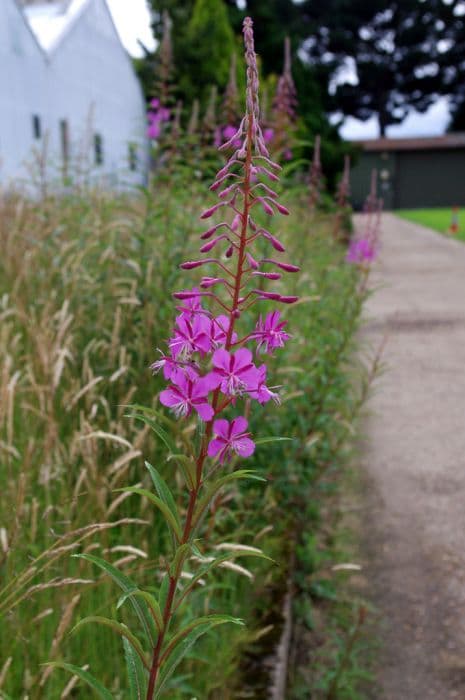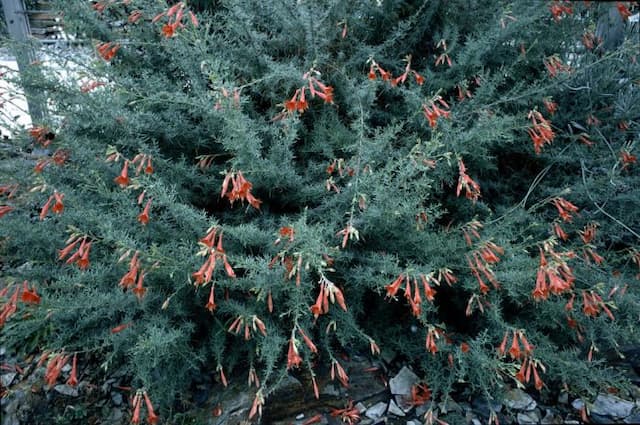Dancing Flame Fuchsia Fuchsia 'Dancing Flame' (d)

ABOUT
Fuchsia 'Dancing Flame' is a strikingly ornamental plant known for its vibrant and pendulous flowers that add a dash of exotic beauty wherever they are grown. The flowers are exceptionally showy, with a bold color palette that usually includes shades of pink, purple, and red. The blooms possess a unique shape, resembling tiers of a skirt that gives them the appearance of tiny ballerinas in mid-twirl, hence contributing to the name 'Dancing Flame'. The plant bears long, tubular flowers that dangle elegantly from slender stems, usually in a mass of contrasting colors. Outer petals flare out beautifully from the base, while inner petals, often in a deeper or contrasting hue, form an inner skirt that envelops the stamens and pistil of the flower. The sepals, which are the green leaf-like parts at the base of the flowers, typically curve elegantly away from the petals, creating a lovely backdrop and enhancing the overall flamboyance of the bloom. The foliage of 'Dancing Flame' provides a lush and vibrant backdrop for the flowers, with leaves that are normally dark green in color. The leaves may have a slightly purple or reddish undertone, which can intensify the visual appeal of the plant, especially when it is in full bloom. These soft and often slightly serrated leaves are arranged oppositely along the stems, which can be somewhat trailing or cascading, adding to the plant's decorative nature. Overall, Fuchsia 'Dancing Flame' is celebrated for its ornate blossoms and graceful growth habit that makes it an ideal choice for hanging baskets, containers, or as a feature in garden beds where its cascading form can be admired. It's the interplay of vivid colors and distinctive form that defines the beauty of this plant, providing an eye-catching spectacle in any garden space it graces.
About this plant
 Names
NamesFamily
Onagraceae
Synonyms
Dancing Flame Fuchsia, Lady's Eardrops
Common names
Fuchsia 'Dancing Flame'
 Toxicity
ToxicityTo humans
The Fuchsia plant is not generally considered toxic to humans. There is no widespread documentation of it causing serious harm if ingested. However, some people might experience mild gastrointestinal discomfort if they consume parts of the plant, such as the berries or leaves. It is always advisable to be cautious and avoid eating plants that are not commonly recognized as food.
To pets
Fuchsia plants are also not considered toxic to pets. They are generally safe around animals, and there is no significant risk of poisoning if pets happen to ingest parts of the plant. As with humans, while the Fuchsia isn't toxic, it's still best to prevent pets from consuming plants that are not intended for their diet, as they could potentially cause mild gastrointestinal upset.
 Characteristics
CharacteristicsLife cycle
Perennials
Foliage type
Deciduous
Color of leaves
Green
Flower color
Mixed
Height
1-2 feet (30-60 cm)
Spread
1-2 feet (30-60 cm)
Plant type
Shrub
Hardiness zones
10
Native area
Central and South America
Benefits
 General Benefits
General Benefits- Ornamental Appeal: Fuchsia 'Dancing Flame' adds vibrant colors and unique, decorative flowers to gardens and containers.
- Attracts Pollinators: The brightly colored flowers attract bees, butterflies, and hummingbirds, promoting biodiversity.
- Shade Tolerance: This plant can thrive in partial shade, making it suitable for garden spots that don't receive full sunlight.
- Long Blooming Period: Fuchsia 'Dancing Flame' has a lengthy blooming season, providing consistent beauty throughout the growing months.
- Versatility: It works well in hanging baskets, window boxes, and containers, as well as in mixed flower borders.
- Easy Propagation: This plant can be easily propagated from cuttings, allowing gardeners to expand their collection or share with others.
- Compact Growth: Its growth habit is compact and bushy, which makes it easy to manage and ideal for small spaces.
 Medical Properties
Medical PropertiesThis plant is not used for medical purposes.
 Air-purifying Qualities
Air-purifying QualitiesThis plant is not specifically known for air purifying qualities.
 Other Uses
Other Uses- Container Gardening: The Fuchsia 'Dancing Flame' is suitable for hanging baskets and containers due to its trailing habit and vibrant flowers, providing a colorful display on patios or balconies.
- Floral Arrangements: The distinctive flowers can be used in cut floral arrangements, adding a touch of exotic beauty to bouquets and indoor decorations.
- Bonsai: With careful pruning and training, Fuchsia 'Dancing Flame' can be grown as a bonsai, offering a challenging yet rewarding project for enthusiasts.
- Butterfly Garden: The plant can be included in butterfly gardens, as its flowers attract pollinators such as butterflies and hummingbirds, promoting biodiversity.
- Edible Garnish: The flowers of Fuchsia 'Dancing Flame' are edible and can be used to add a splash of color and a slight acidic flavor to salads or desserts.
- Photography: Its unique flowers provide an excellent subject for photography, especially for macro photography enthusiasts aiming to capture its intricate details.
- Water Features: Fuchsia 'Dancing Flame' can be planted around ponds or water features where its bright flowers and dark foliage contrast with the tranquility of the water, enhancing the overall beauty of the area.
- Textile Dyeing: Historically, some fuchsia species' berries were used for dyeing fabrics, and Fuchsia 'Dancing Flame' flowers may provide pigments for natural dye projects.
- Craft Projects: The flowers and leaves can be used in pressed flower art or botanical crafts, bringing natural elements into various DIY projects.
- Teaching Tool: Fuchsia 'Dancing Flame' is an excellent teaching tool for lessons in botany or horticulture, providing first-hand experience with plant growth, reproduction, and care.
Interesting Facts
 Feng Shui
Feng ShuiThe Fuchsia is not used in Feng Shui practice.
 Zodiac Sign Compitability
Zodiac Sign CompitabilityThe Fuchsia is not used in astrology practice.
 Plant Symbolism
Plant Symbolism- Confidence: The bright and bold colors of the Fuchsia often symbolize confidence and self-assurance, encouraging individuals to stand out and express themselves.
- Vivaciousness: The vibrant appearance of the Fuchsia, especially the 'Dancing Flame' variety, represents lively energy and an exuberant spirit, similar to a dynamic flame.
- Elegance: Fuchsias are also known for their elegant, pendulous flowers, which can symbolize grace and sophistication.
- Good Taste: The Fuchsia's unique and attractive appearance is often associated with having good taste or appreciation for refined beauty.
- Overflowing Abundance: With its prolific blooms that dangle like clusters of gems, the Fuchsia can represent generosity and abundance.
- Warning: In the Victorian language of flowers, Fuchsia could also represent a warning, or more specifically, a polite way of saying confiding in someone is risky.
 Water
WaterThe Fuchsia, or Dancing Flame, should be watered thoroughly whenever the top inch of soil feels dry. This typically means watering once or twice a week, depending on the climate and the plant's exposure to heat and sunlight. Water should be applied slowly to ensure it reaches the roots rather than just wetting the surface. Each watering session should provide enough water so that it begins to drain from the bottom of the pot, indicating that the soil is sufficiently saturated. During the peak growing season, the plant may need closer to two gallons of water per week, but always adjust the quantity based on the soil's moisture level rather than a fixed schedule.
 Light
LightDancing Flames prefer bright, indirect light and should be placed in a spot where they are protected from the harsh afternoon sun. Ideal conditions include a north or east-facing windowsill or a shaded part of a patio where they receive gentle morning light or dappled sunlight throughout the day. Direct sunlight can scorch the leaves, so care should be taken to ensure the light is sufficiently filtered or diffused.
 Temperature
TemperatureThe Dancing Flame Fuchsia thrives in temperatures between 55 and 75 degrees Fahrenheit and can tolerate a minimum temperature of around 40 degrees at night. Extreme heat can stress the plant, so it's vital to keep them away from hot, dry conditions. They are not tolerant of frost and should be protected or brought indoors when outdoor temperatures start dipping below the minimum threshold.
 Pruning
PruningPruning is essential for maintaining the shape of the Dancing Flame Fuchsia and encouraging bushier growth. Prune in late winter or early spring before new growth begins, cutting back by about a third to stimulate new shoots. Additionally, deadheading, or removing spent flowers, will promote further blooming throughout the season. Pruning may also be done after the main flush of flowers diminishes to rejuvenate the plant and prepare for a second blooming period.
 Cleaning
CleaningAs needed
 Soil
SoilFuchsias like 'Dancing Flame' thrive in a well-draining, fertile potting mix enriched with peat moss, perlite, and compost. Maintain a soil pH between 6.0 and 7.0 to keep the plant healthy.
 Repotting
RepottingFuchsias like 'Dancing Flame' should be repotted annually, usually in the spring before new growth starts, to refresh the soil and accommodate root growth.
 Humidity & Misting
Humidity & MistingFuchsias like 'Dancing Flame' prefer high humidity levels, ideally between 60% and 70%, to flourish and produce their vibrant blossoms.
 Suitable locations
Suitable locationsIndoor
Keep in bright, indirect light and high humidity.
Outdoor
Place in dappled shade, shelter from strong winds.
Hardiness zone
10-11 USDA
 Life cycle
Life cycleFuchsia 'Dancing Flame' begins its life as a seed, which germinates in warm, moist soil conditions, commonly in late winter or early spring. The seedling emerges and develops into a young plant with characteristic fuchsia foliage, during which adequate light and water are essential for vigorous growth. As the plant matures, it enters a vegetative stage, producing stems and leaves, and with proper care, it starts to form distinctive pendulous flowers, often in shades of pink, purple, and white, which attract pollinators such as hummingbirds and bees. Following pollination, the flowers develop into small fruit-bearing pods that contain seeds, completing the reproductive cycle. In temperate regions, Fuchsia 'Dancing Flame' may enter dormancy during the cold months, losing leaves and ceasing growth, only to resume its growth cycle with warmer temperatures in spring. Pruning is often necessary after dormancy to encourage bushier growth and more abundant flowering in the following season.
 Propogation
PropogationPropogation time
Spring-Early Summer
Fuchsia 'Dancing Flame', commonly known as hardy fuchsia, is typically propagated by softwood cuttings during late spring to early summer. The most popular method involves taking a 2 to 4 inch cutting from a non-flowering shoot, making the cut just below a leaf joint. The lower leaves are removed, and the cut end may be dipped in rooting hormone to encourage root development. The cutting is then inserted into a pot filled with a mix of peat and perlite or a similar free-draining propagation medium. The pot is then covered with a plastic bag or placed in a propagator to maintain high humidity around the cutting, and kept in a warm place with indirect light. Roots usually develop in 3 to 4 weeks, after which the new plant can be gradually acclimatized to less humid conditions before potting on.









